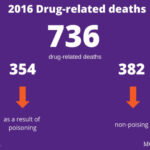Malnutrition in the homeless population | Dr Sharon Kennelly
Sharon Kennelly is a Clinical Specialist Dietitian working in the HSE Primary Care Service Improvement Programme. She has a PhD in the subject area of the identification and treatment of malnutrition in the community setting, and is a member of the Irish Nutrition & Dietetics Institute (INDI).
Malnutrition in Ireland
When we hear the term malnutrition our first thought can be that it is an issue seen only in developing countries. However malnutrition is commonly seen in healthcare settings in Ireland with an estimated 145,000 people potentially at risk at any one time. In Ireland approximately one quarter of those admitted to hospital have been found to be at risk of malnutrition.
Studies investigating rates of malnutrition in Ireland are generally focused on those who have chronic diseases or older people, and exact figures regarding the prevalence of malnutrition in the homeless population are lacking. However front-line clinicians working with those who are homeless in Ireland have highlighted the fact that they regularly observe, as part of their daily work, people who are either visibly underweight or have had significant amount of weight loss. International studies report that between 6% and 33% of people who are homeless are malnourished. This would compare to a rate of approximately 2% in the general population in Ireland. People using night shelters and those who are sleeping rough are found to be most at risk, as well as those who have a substance addiction.
The effects of malnutrition on a person’s health include reduced muscle strength and fatigue, poorer immune response, delayed wound healing, delayed recovery from illness, and reduced response to medical interventions. Malnutrition is also associated with higher rates of depression.
Malnutrition and homelessness
When we think of the possible underlying causes of malnutrition in the homeless population there are many factors involved. Similar to the general population the presence of chronic disease, such as diseases of the lungs or gastrointestinal system which can increase the body’s nutritional requirements and reduce ability to absorb nutrition, are a factor. Taking multiple medicines can affect appetite and taste. The presence of gastrointestinal symptoms such as constipation and nausea can reduce appetite. Social factors such as lack of money to buy food or low prioritisation of food over addictive substances, difficulty planning meals, and lack of cooking facilities are all challenges. Physical issues such as impaired mobility may also be present. And psychological factors such as cognitive impairment and depression may also affect appetite.
For those with problematic drug use, all of the above considerations apply, with the addition of the pharmacological effect of drugs and excess alcohol. These can severely affect appetite and the body’s ability to absorb nutrients.
What can clinicians do to identify and provide first-line treatment of malnutrition?
Screening using a validated screening tool such as the ‘MUST’ (Malnutrition Universal Screening Tool), developed by the UK BAPEN group, is recommended to identify malnutrition. The tool has three steps and takes less than five minutes to complete. An easy to use version can be found online at https://www.bapen.org.uk/screening-and-must/must-calculator.
People found to be at risk of malnutrition should be referred to a dietitian for specialist advice. However it is recognised that there can be delays and absence of service in some areas and in addition patients referred may not attend appointments. So while this is good practice, it may not always be practical. Community dietitians can be a source of training and information to those working in front-line services and can advise on cases of concern.
To aid clinicians, a step-by-step pathway to the first-line management of malnutrition and use of standard oral nutritional supplements (ONS) is available at www.hse.ie/nutritionsupports. While not specifically tailored for people who are homeless, the feedback to date is that many clinicians working with this group have used these resources and find them helpful in their practice.
High-protein, high-calorie dietary advice
A high-protein high-calorie diet is recommended for people found to be at risk of malnutrition. This means encouraging intake of protein and calorie-rich foods. These include full-fat dairy products, such as milk, cheese, yogurt, butter and cream, and other protein rich foods like meat, fish, beans, eggs, and nuts. It is important not to leave long gaps between meals, and to eat little and often if the appetite is poor.
In places where people who are homeless access services, offering free snacks particularly high-protein high-calorie options such as full-fat milk and yogurt drinks, sandwiches with a protein source (such as meat, eggs ,cheese, fish), energy bars with dried fruit or nuts, can be helpful.
For those involved in food provision, high-protein, high-calorie recipes are available online in the Making the Most of Every Bite cookbook developed by dietitians at University College Cork and the HSE. This is available online via the nutrition supports toolkit. A basic leaflet based on tips from the cookbook is available to view or download at the nutrition supports website link above. This leaflet is in plain English, approved by the National Adult Literacy Agency (NALA).
While this type of dietary advice may seem in conflict with traditional healthy eating advice, the priority is ensuring something nourishing is being eaten, especially for high-risk groups as mentioned earlier.
Oral nutritional supplements
There is some debate about the use of oral nutritional supplements (ONS) in the homeless population. ONS are foods for special medical purposes that can be prescribed to treat malnutrition. Typically these are powdered or ready made milkshake or juice-style products. Problems with prescribing ONS to people with substance addictions that have been reported include: Once started on ONS it can be difficult to stop prescriptions; ONS may be used instead of meals rather than additional to meals and therefore provide no benefit; the products may be given to others e.g. family/friends, or may be sold and used as a source of income. It can also be hard to monitor nutritional status and assess on-going need for ONS due to poor attendance at clinic appointments.
However if people who are homeless are found to be malnourished or at risk of malnutrition due to disease or lifestyle factors, prescribing ONS could be of benefit to their health if they are taken appropriately. Practical suggestions to overcome concerns could be an agreement between the prescriber and the patient to attend regular appointment for review while ONS are prescribed, so that weight can be checked. The provision of ONS (such as powdered milkshake style which can be mixed with fresh milk) at treatment centres or clinics where they could be consumed on-site by people who are identified by clinicians as requiring them, is also an option that could be considered . If after a period of review the person is not benefiting, due to lack of compliance, they could be discontinued.
Find out more:
Nutrition screening by those working in front-line homeless services can help to identify and treat malnutrition in the homeless population, although there are challenges. Online toolkits such as www.hse.ie/nutritionsupports and further training from local community dietitian services may help clinicians working at the front line with people who are homeless. Links to resources including web-based MUST training and contact details for community dietitian services are available at www.hse.ie/nutritionsupports.
Where there is no current identified risk of malnutrition, a HSE funded programme called Health Food Made Easy, is available for vulnerable groups in some areas. This involves peer-led education around healthy eating and practical cookery lessons. Local HSE community dietitians can provide more information.
You can find out more about Merchants Quay Ireland’s services by clicking the link here.

